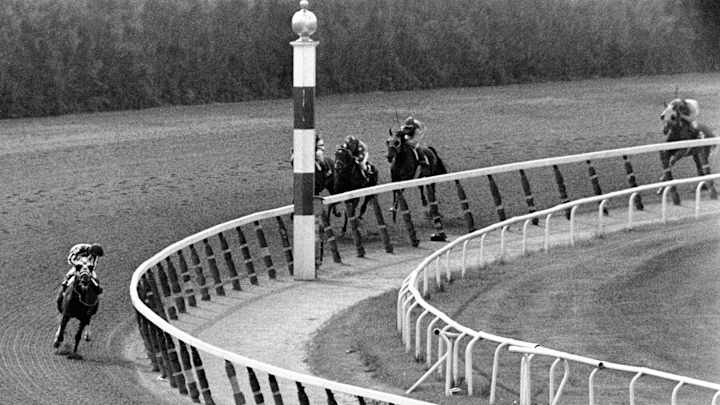First race back for Triple Crown winners usually a success

OCEANPORT, N.J. (AP) American Pharoah will attempt to do what many Triple Crown champions have done throughout history - win the first race after victories in the Kentucky Derby, Preakness and Belmont Stakes.
Racing's 12th Triple Crown winner takes on six rivals in the Haskell Invitational at Monmouth Park on Sunday. Of the 11 other Triple winners, 10 returned to racing and seven of them won.
Count Fleet did not run again after winning the Belmont in 1943 because of a leg injury. The losers? Seattle Slew finished fourth behind J.O. Tobin in the 1977 Swaps Stakes, Omaha ran third to Discovery in the 1935 Brooklyn Handicap, and Sir Barton was second to Purchase in the 1919 Dwyer.
The average time between the Belmont and the next race for Triple Crown winners is about five weeks. American Pharoah comes into the Haskell 57 days after the Belmont. Secretariat won the 1973 Arlington International by nine lengths 21 days after his record 31-length victory.
''It was a stroll in the park,'' recalls Secretariat's jockey Ron Turcotte. ''The crowd showed up to adore the great horse and got just what they wanted.''
A look at how the first 11 Triple Crown winners fared:
---
SIR BARTON (1919)
After winning the first four races of his career in a 32-day span - the Derby, Preakness, Withers and Belmont - Sir Barton finished three lengths behind Purchase in the Dwyer at Aqueduct. The race came 29 days after the Belmont. As a 4-year-old, he beat Exterminator in the Saratoga Handicap and lost to Man o' War in a match race. He was retired with 13 wins in 31 starts.
---
GALLANT FOX (1930)
After a 21-day break following the Belmont, the bay with a white blaze easily won the Dwyer against a weak field at 1-10 odds. He won four of his last five starts and was retired after his victory in the Jockey Club Gold Cup on Sept. 17, 1930. That loss came in the Travers to 100-1 long shot Jim Dandy, and reinforced Saratoga's reputation as the ''Graveyard of Favorites.''
---
OMAHA (1935)
After his Triple Crown sweep (he won the Withers between the Preakness and Belmont), Omaha ran third in the Brooklyn Handicap. The race came two weeks after the Belmont. A son of Gallant Fox, he ran four times in Britain as a 4-year-old and was retired.
---
WAR ADMIRAL (1937)
The Admiral injured his right front heel at the start of the Belmont, so after his win he was given time off. He returned nearly five months later and won an allowance race in Laurel, and four days later won the Washington Handicap. By the end of 1938, War Admiral was beaten in a match race by Seabiscuit at Pimlico. He was retired after he won his only race as a 5-year-old.
---
WHIRLAWAY (1941)
With Eddie Arcaro aboard, Whirlaway had only three rivals in the Belmont. Two weeks later, he won the Dwyer by 1 1/4 lengths. It was only the midway point of a career that totaled 60 races - 32 wins, 15 seconds and nine thirds. No Triple Crown winner ever ran more races.
---
COUNT FLEET (1943)
Won the Derby by three lengths, the Preakness by eight and the Belmont by a then-record 25 lengths. He won all six of his races as a 3-year-old, but injured his leg in the Belmont and never raced again. He was retired with 16 wins, four seconds and one third in 21 races.
---
ASSAULT (1946)
Another Triple champion who came back two weeks after the Belmont and won the Dwyer - by 4 1/2 lengths. The colt then lost six in a row before his next victory and was retired after two races as a 7-year-old. He finished with 18 wins in 42 starts.
---
CITATION (1948)
A little over three weeks after his breeze in the Triple Crown, Citation won the Stars and Stripes Handicap at Arlington Park. Big Cy won the Derby by 3 1/2 lengths, the Preakness by 5 1/2 lengths and the Belmont by eight lengths. He also won the Jersey Derby by 11 lengths between the Preakness and Belmont. In 45 career races, he won 32, ran second in 10 and third in two.
---
SECRETARIAT (1973)
It took 25 years before the next Triple Crown winner, and Big Red is considered the best of them all. He recorded record times in each of the Triple Crown races. Then, he easily won the Arlington Invitational at Arlington Park by nine lengths three weeks after the Belmont. He was sent off at 1-20 odds. Seemingly invincible, he was upset by Onion in his next race, the Whitney at Saratoga - once again proving the track is a ''Graveyard of Favorites.'' Secretariat was retired after his 3-year-old season with a total of 16 wins, three seconds and a third in 21 starts.
---
SEATTLE SLEW (1977)
Racing's only undefeated Triple Crown winner, Slew was beaten in his first race after his sweep. He finished fourth in the Swaps Stakes at Hollywood Park - 16 lengths behind J.O. Tobin, a horse he defeated in the Preakness. Physical ailments sidelined him the rest of the year, but he came back and won five of seven as a 4-year-old. He was retired with 14 wins in 17 starts.
---
AFFIRMED (1978)
After outdueling rival Alydar in all three races to give the sport its third Triple Crown of the decade, Affirmed closed with a rush in the final 100 yards and edged Sensitive Prince - and avoided an upset in the Jim Dandy at Saratoga. He finished first in the Travers in his next race (Laffit Pincay subbed for injured regular rider Steve Cauthen), but was disqualified and placed second for cutting off Alydar entering the far turn. Affirmed won 22 of 29 lifetime starts.
---
Follow Richard Rosenblatt on Twitter at: http://www.twitter.com/rosenblattap
